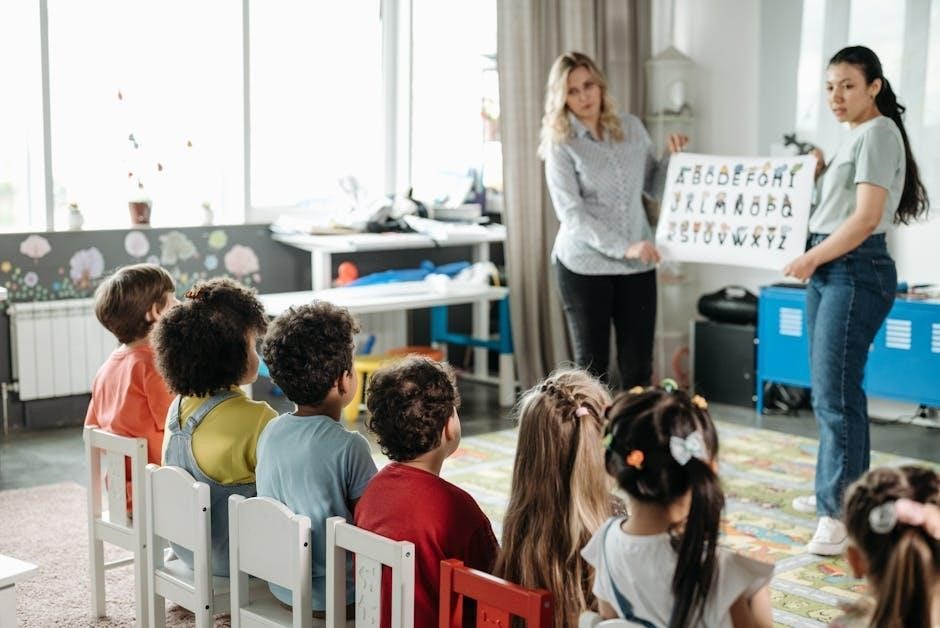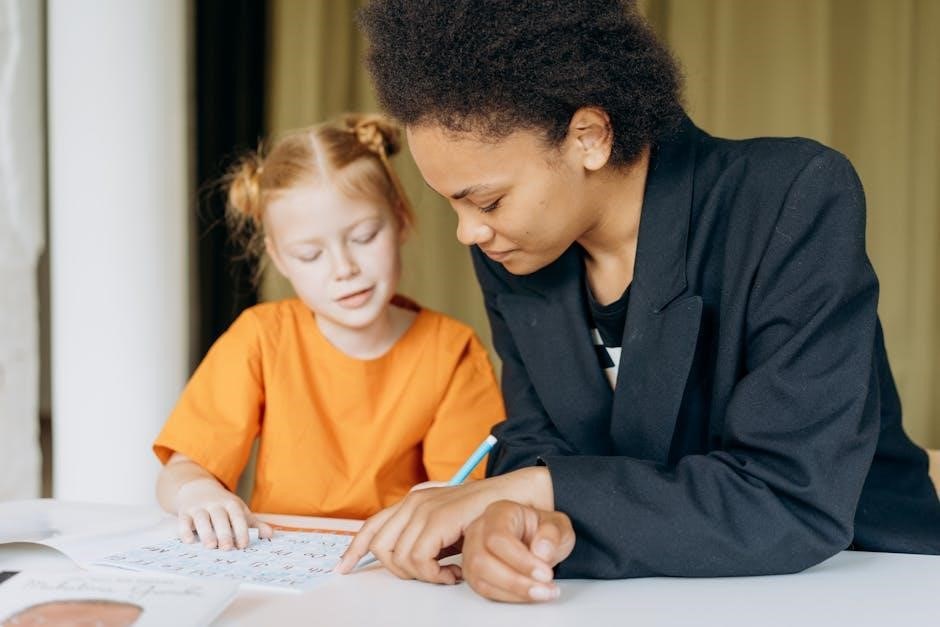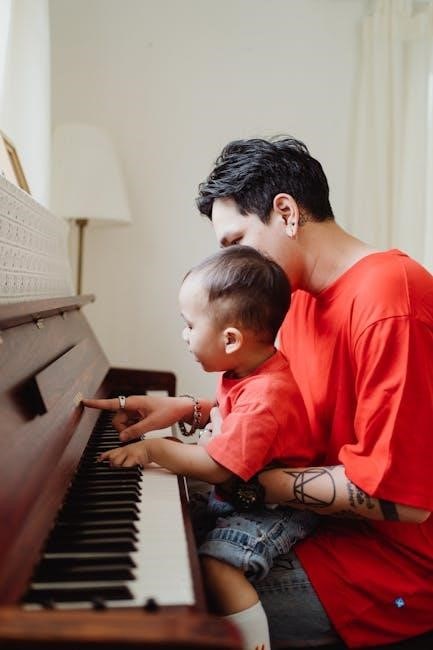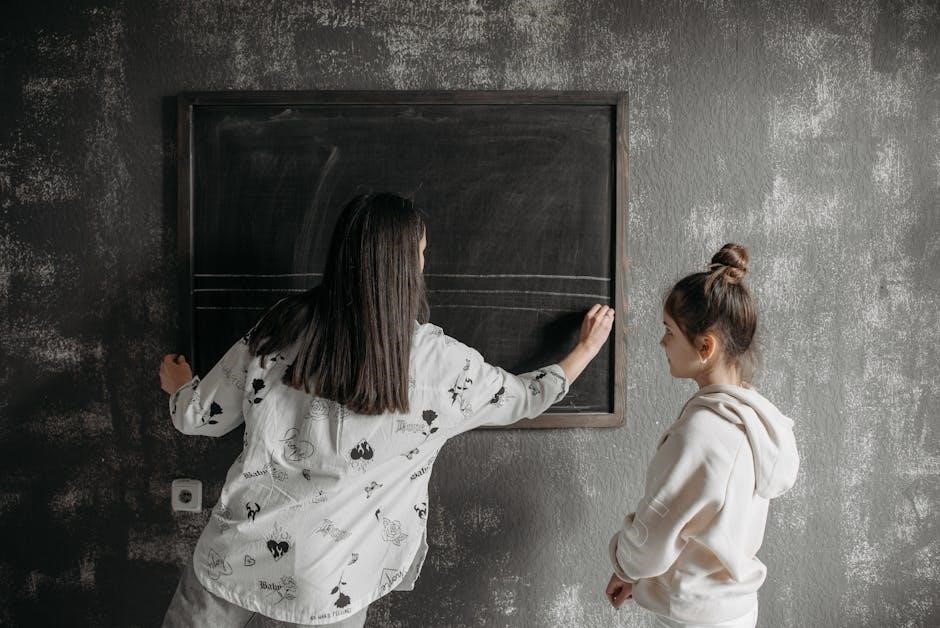Free Preschool Music Lesson Plans: An Overview
Engage young minds with free preschool music lesson plans, often available in PDF format․ These resources offer structured activities that introduce fundamental musical concepts through singing, movement, and instrument play, fostering creativity and development․
Benefits of Music Education in Preschool
Music education in preschool offers numerous benefits, enhancing cognitive, physical, social-emotional, and language development․ Engaging with music through lesson plans improves memory, attention span, and coordination․ Activities like singing and chanting help build vocal skills and expand vocabulary․ Rhythm instrument exercises foster an understanding of beat and timing, while movement and dance encourage self-expression and physical activity․ Furthermore, music promotes social interaction and cooperation, developing crucial social skills․ Early exposure to music cultivates a lifelong appreciation for the arts, enriching children’s lives and fostering creativity and self-expression in a fun and engaging way․
Key Elements of Effective Preschool Music Lesson Plans
Effective preschool music lesson plans should incorporate several key elements to maximize engagement and learning․ A good plan includes warm-up activities to prepare children for musical exploration, followed by singing and chanting to develop vocal skills․ Rhythm instrument activities introduce percussion and beat recognition, while movement and dance encourage physical expression․ Play-based learning ideas integrate music with play, fostering creativity and enjoyment․ Adaptability is crucial, allowing modification for different age groups and skill levels․ Familiar songs and themes enhance engagement, and using everyday materials for instruments promotes resourcefulness․ Finally, integrating music with other subjects creates a holistic and enriching learning experience for preschoolers․

Finding Free Preschool Music Lesson Plans
Discovering free preschool music lesson plans is easier than you think, thanks to the internet․ Explore online resources, printable sheet music, and video platforms like YouTube for a wealth of options․
Online Resources for Free Music Lesson Plans
Numerous websites offer free music lesson plans designed for preschoolers․ These platforms often provide downloadable PDFs that include structured activities, song suggestions, and movement exercises․ Look for resources from educational organizations, teacher blogs, and music education websites․ Many sites offer sample lessons or trial periods to access their full range of materials, ensuring that you can find something suitable for your needs․
Utilize search engines with keywords like “free preschool music lesson plans PDF” to broaden your search․ Remember to evaluate the credibility and quality of the resources before implementing them in your classroom or home setting․
Free Printable Sheet Music for Preschoolers
Finding free printable sheet music tailored for preschoolers can greatly enhance music education․ Look for simplified arrangements of familiar children’s songs with large, easy-to-read notes․ Many websites dedicated to early childhood music education offer free downloads of sheet music specifically designed for young learners․ These resources often include lyrics and chord symbols to aid in teaching and accompaniment․
Consider searching for public domain songs, as these are often available for free use and distribution․ Sites like “Music for Kiddos” or general music education blogs often have curated collections․ Remember to check the copyright status of any sheet music before using it․
Utilizing YouTube and Google for Music Resources
YouTube and Google are treasure troves for preschool music resources, offering a wealth of songs, activities, and instructional videos․ Search for “preschool music activities” or specific songs like “Hot Cross Buns” to find engaging content․ YouTube provides visual demonstrations of actions, dances, and instrument playing, making learning interactive․
Google can lead you to free lesson plans, printable resources, and articles on early childhood music education․ Be sure to preview content for age-appropriateness and quality before sharing it with children․ Look for channels and websites created by experienced music educators for reliable information․

Components of a Preschool Music Lesson Plan PDF
A comprehensive preschool music lesson plan PDF includes warm-up activities, singing, rhythm instrument exploration, movement, and play-based learning ideas․ These components foster holistic development through musical engagement․
Warm-up Activities: Getting Started with Music
Preschool music lessons should always begin with engaging warm-up activities․ These initial exercises prepare young children both physically and mentally for musical exploration․ Warm-ups can involve simple stretches, movement games, or vocal exercises that encourage children to use their bodies and voices․ Activities like mimicking animal sounds or following a leader in a series of actions help improve focus and coordination․ The goal is to create a playful and relaxed atmosphere where children feel comfortable participating․ Incorporating familiar songs or rhymes into the warm-up routine can also ease children into the lesson and set a positive tone for learning․ These activities are often movement-based․
Singing and Chanting: Building Vocal Skills
Singing and chanting are crucial components of preschool music education, helping to develop vocal skills and a sense of rhythm․ Choose songs that are simple, repetitive, and age-appropriate, featuring clear melodies and engaging lyrics․ Action songs that incorporate movement, such as “Head, Shoulders, Knees, and Toes,” are particularly effective․ Chanting simple rhymes or rhythmic patterns can also help children develop their vocal control and coordination․ Encourage children to sing together as a group, fostering a sense of community and shared experience․ Provide opportunities for individual expression, allowing children to take turns leading songs or creating their own simple chants․ These activities promote language development and cognitive skills․
Rhythm Instrument Activities: Exploring Percussion
Rhythm instrument activities offer preschoolers a hands-on way to explore percussion and develop their sense of rhythm․ Provide a variety of instruments, such as shakers, drums, tambourines, and rhythm sticks, allowing children to experiment with different sounds․ Guide children in playing simple rhythms and patterns, encouraging them to follow along with the beat of a song․ Incorporate call-and-response activities, where you play a rhythm and children echo it back․ Use instruments to represent different characters or sounds in a story, enhancing storytelling and imaginative play․ Encourage children to create their own rhythms and compositions, fostering creativity and self-expression․ These activities develop fine motor skills, coordination, and listening skills, while promoting joyful engagement․
Movement and Dance: Encouraging Physical Expression
Movement and dance activities are crucial for encouraging physical expression in preschool music lessons․ Incorporate songs with actions, like “Head, Shoulders, Knees, and Toes,” to promote body awareness and coordination․ Use scarves or ribbons to encourage free-flowing movement and imaginative expression through dance․ Explore different types of movement, such as stomping, clapping, jumping, and twirling, to develop gross motor skills․ Play music with varying tempos and styles, encouraging children to adapt their movements accordingly․ Introduce simple dance steps or patterns, such as marching or swaying, to foster rhythm and coordination․ Allow children to lead their own movements, fostering creativity and self-expression; These activities enhance physical development, coordination, and self-confidence while making learning fun․
Play-Based Learning Ideas: Integrating Music with Play
Integrate music with play-based learning by creating musical games that reinforce concepts․ Use musical instruments during imaginative play, like having a parade with drums and shakers․ Incorporate songs into storytelling, assigning different characters musical themes․ Set up a “music center” with instruments and props for free exploration․ Use music to transition between activities, creating a predictable routine․ Play musical freeze dance to encourage listening skills and physical activity․ Have children create their own instruments using recycled materials․ Use music to enhance sensory play, like playing calming music during water play․ Integrate music into dramatic play, like creating a band with costumes and instruments․ These ideas blend musical learning with natural play, fostering creativity and engagement․ Play-based learning fosters cognitive, social, and emotional development in young children․
Adapting Lesson Plans for Different Age Groups
Modify preschool music lesson plans to suit varying developmental stages․ Simplify activities for younger children and introduce more complex concepts for older preschoolers, ensuring engagement and comprehension for all age groups․
Modifying Activities for Younger Preschoolers
When working with younger preschoolers, adapt music lesson plans to accommodate their shorter attention spans and developing motor skills․ Focus on simplicity and repetition․ Choose songs with simple melodies and repetitive lyrics, making them easy to learn and sing along to․ Simplify movements, such as basic clapping or swaying, instead of complex dance steps․
Use larger rhythm instruments that are easier to grasp and manipulate․ Keep activities brief, transitioning frequently to maintain interest․ Incorporate visual aids, like picture cards or puppets, to enhance understanding and engagement․ Focus on sensory experiences, using scarves or textured materials to explore music through touch and movement․ Remember that movement-based activities are often a great way to keep younger children engaged․
Challenging Older Preschoolers with Advanced Concepts
To challenge older preschoolers, introduce more complex musical concepts and activities․ Explore varied rhythms and tempos, encouraging them to differentiate between fast and slow, loud and soft․ Introduce basic music notation through visual aids, like color-coded notes or simple graphic scores․
Encourage creative expression through improvisation, allowing them to create their own melodies or rhythmic patterns․ Introduce more challenging movement activities, such as mirroring movements or creating simple choreographies․ Incorporate call-and-response songs with more complex melodic phrases․ Explore different musical genres and cultures, broadening their musical horizons․ Encourage them to express their feelings and emotions through music, fostering emotional intelligence․

Creating Your Own Preschool Music Lesson Plans
Craft personalized preschool music lesson plans by incorporating familiar songs, using everyday materials for instruments, and integrating musical concepts with other subject areas, fostering holistic learning․
Incorporating Familiar Songs and Themes
When creating your own preschool music lesson plans, consider the power of familiarity․ Children respond positively to songs and themes they already know and love․ Incorporating classics like “Hot Cross Buns” or nursery rhymes creates an instant connection and fosters engagement․
Think about seasonal themes or everyday experiences that resonate with preschoolers, such as animals, colors, or transportation․ These themes can be woven into your lessons through songs, stories, and activities․ For example, a lesson on animals could include songs about farm animals or jungle creatures, along with movement activities that mimic their actions․
By building on familiar foundations, you can create a comfortable and enjoyable learning environment where children feel confident to participate and explore the world of music․
Using Everyday Materials for Instruments
Unleash your creativity and save money by using everyday materials to create simple instruments for your preschool music lessons․ This hands-on approach not only makes music accessible but also encourages resourcefulness and imaginative play․
Empty plastic bottles filled with rice or beans become shakers, while pots and pans transform into drums․ Wooden spoons make excellent drumsticks, and rubber bands stretched around boxes create makeshift guitars․ Consider using scarves for free self-expression through dancing․
Involve the children in the instrument-making process to enhance their sense of ownership and excitement․ Discuss the different sounds each instrument makes and explore how they can be used to create rhythms and melodies․ This activity fosters creativity, fine motor skills, and an understanding of sound․
Integrating Music with Other Subjects
Enhance learning by seamlessly integrating music with other subjects in your preschool curriculum․ This interdisciplinary approach reinforces concepts and makes learning more engaging and memorable․
Use songs and rhythms to teach the alphabet, numbers, and colors․ Create a song about the life cycle of a butterfly during a science lesson or use musical instruments to represent different characters in a story․ Develop math skills with music․
Movement-based activities can be used to explore shapes and spatial awareness․ Incorporate music into social studies by learning about different cultures through their traditional songs and dances․ By weaving music into various subject areas, you create a holistic and enriching learning experience for your preschoolers․

Sample Preschool Music Lesson Plan Activities
Explore sample preschool music lesson plan activities that provide practical examples for incorporating music into your classroom․ These activities offer creative ideas for engaging young children with music and movement․
Example 1: “Hot Cross Buns” Lesson Plan
This lesson introduces “Hot Cross Buns” to preschoolers, fostering musical learning through a familiar song․ Begin with singing the song, using printable sheet music․ Integrate rhythm instruments like shakers and drums to keep the beat, enhancing rhythmic awareness․ Incorporate movement by having children act out baking or selling hot cross buns․ Extend the activity with an art project where children draw or paint their own hot cross buns․
Adapt the lesson by varying the tempo and dynamics, encouraging creative expression․ Play-based learning can be integrated by using toy ovens and play money; This multi-sensory approach makes learning engaging and memorable․
Example 2: Movement-Based Activities with Scarves
Engage preschoolers in creative movement with scarves, promoting physical expression and coordination․ Begin by distributing colorful scarves and playing various musical recordings․ Encourage children to move freely with the music, using the scarves to express their interpretation․ Introduce simple movements like waving, swirling, and tossing the scarves․ Incorporate different tempos and dynamics, prompting varied responses․
Use scarves to illustrate musical concepts such as high and low notes, fast and slow rhythms․ Encourage interaction by having children mirror each other’s movements․ This activity enhances creativity, coordination, and musical awareness․ Adaptations can include using different types of music and props․
